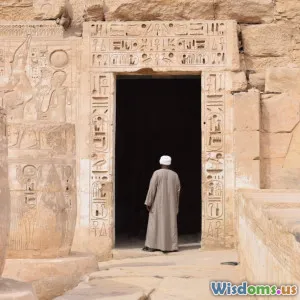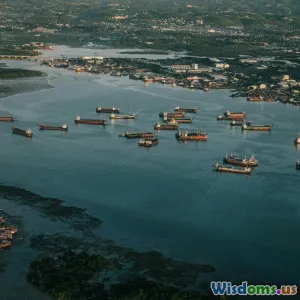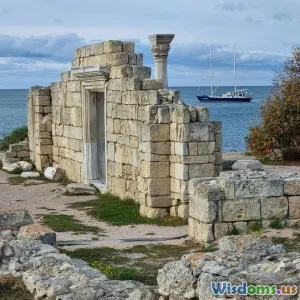
How Mesopotamian Merchants Revolutionized River Trade Economics
8 min read Explore how Mesopotamian merchants transformed river trade economics through innovation, fostering economic growth and connectivity in the ancient world. (0 Reviews)
How Mesopotamian Merchants Revolutionized River Trade Economics
Mesopotamia, often called the "Cradle of Civilization," holds a monumental place in human history, not only for its pioneering contributions to writing, law, and urban development but also for breaking new ground in the economics of trade. Central to this transformation were the merchants of Mesopotamia, whose innovative approaches to river trade sculpted the economic landscape of the ancient Near East and beyond.
By harnessing the rivers Tigris and Euphrates as commercial lifelines, Mesopotamian merchants did not just facilitate the movement of goods; they created an intricate system of economic organization, credit, and exchange that radically altered trade dynamics and set the foundation for future civilizations.
Navigating the Geographic and Economic Context
The fertile land between the Tigris and Euphrates rivers presented an unparalleled opportunity for agriculture and settlement but also posed unique challenges and opportunities for trade. The rivers were not simply natural landmarks; they were vital arteries enabling the exchange of commodities such as grain, textiles, timber, metals, and luxury items.
The Strategic Importance of Riverways
Unlike later overland trade routes, river trade in Mesopotamia allowed for the movement of large volumes of goods with greater speed and lesser cost. Mesopotamian merchants capitalized on this by developing watercraft, ports, and transshipment points optimized for efficient loading and unloading. The rivers became a circulatory system where goods and wealth continuously flowed.
Innovations in Trade Organization
Mesopotamian merchants introduced sophisticated organizational practices that influenced the growth and stability of trade.
The Development of a Merchant Class
Unlike in many early societies where centralized authorities controlled trade, Mesopotamia saw the rise of an autonomous merchant class—professional traders who specialized in buying, selling, and managing logistics. This class often collaborated with temples and palaces, which acted as economic hubs, thereby interweaving private enterprise with state interests.
Record Keeping and Contracts
One of the most transformative innovations was the use of cuneiform tablets to record transactions, credit arrangements, and contracts. These clay tablets documented trade agreements safeguarding interests and minimizing disputes. An example from Uruk circa 3000 BCE shows consignments of barley delivered with specified terms, illustrating a sophisticated understanding of trade law.
Financing and Credit
Mesopotamian merchants utilized credit systems evidenced by tablets that show loans with interest, promissory notes, and partnership agreements called "mudharaba" – early forms of joint ventures. These financial tools enabled merchants to mobilize resources, invest in larger trade expeditions, and absorb risks inherent in long-distance trade.
Expanding Trade Networks
The efforts of Mesopotamian merchants expanded commerce far beyond local markets.
Long-Distance Trade and Exchange
Archaeological evidence, including imported lapis lazuli from Afghanistan and cedar from Lebanon, confirms the vast reach of Mesopotamian trade networks operated by merchants. Goods travelled via the rivers and overland caravan routes, connecting distant regions and creating a proto-global economy of the ancient world.
Merchants as Cultural and Economic Bridges
Merchants did more than trade goods; they exchanged ideas, technologies, and cultural practices, acting as conduits for civilizational development. The spread of writing systems, metallurgical techniques, and religious concepts often followed merchant roads and riverways.
Impact on Economic Thought and Systems
The revolutionary contributions of Mesopotamian merchants extend beyond their immediate trade successes; they influenced enduring economic principles.
Emergence of Market Principles
The merchant activities introduced supply and demand dynamics, price-setting, and market regulation. The commodity prices recorded in Hammurabi’s era reveal attempts to stabilize markets, demonstrating early economic policy intervention influenced by trade realities.
Foundation for Contract Law
The meticulous documentation of trade contracts inspired legal frameworks formalizing commercial transactions—principles that resonate in modern commercial law and contract theory.
Lessons for Modern Economics and Trade
Studying Mesopotamian merchants provides invaluable insights into how economic systems evolve. Their balance of innovation, risk management, and integration with state institutions showcases effective trade dynamics applicable even today.
Innovations Preceding Modern Finance
The concept of credit, partnerships, and insurance-like practices in Mesopotamian trade presage modern financial instruments, underscoring that economic innovation is a continuum shaped by necessity and creativity.
River Trade as a Model for Network Connectivity
Their utilization of river networks as economic corridors parallels today's interest in waterways for transport efficiency and international trade routes such as the Rhine or the Mississippi.
Conclusion
The Mesopotamian merchants’ role in shaping river trade economics was nothing short of revolutionary. By pioneering organization, finance, and expansive trade networks along Mesopotamia’s vital rivers, they transformed commerce from mere exchange into a complex economic system that influenced civilizations that followed.
Far from a mere historical curiosity, their innovations encapsulate fundamental truths about trade and economics, highlighting how geography, technology, and social organization interplay to drive economic progress. The lessons distilled from their endeavors remain relevant for understanding economic connections and innovations in today’s interconnected world.
References:
- Crawford, Harriet E.W. Sumer and the Sumerians. Cambridge University Press, 2004.
- Postgate, J.N. Early Mesopotamia: Society and Economy at the Dawn of History. Routledge, 1992.
- Algaze, Guillermo. The Uruk World System: The Dynamics of Expansion of Early Mesopotamian Civilization. University of Chicago Press, 1993.
- Van de Mieroop, Marc. Trade and Markets in the Ancient Near East. Wiley-Blackwell, 2020.
The economic ingenuity of Mesopotamian merchants serves as a timeless testament to human innovation in commerce and the enduring power of trade networks.
Rate the Post
User Reviews
Popular Posts





















